LAB REPORT
Science and Technology Making Headlines
May 21, 2021

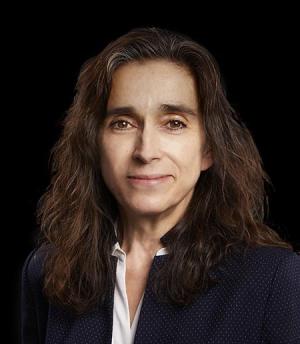
LLNL Director Kim Budil
A director’s perspective on the Lab
Kim Budil, a physicist and Livermore veteran, is the first woman to lead Lawrence Livermore National Laboratory. She recently sat down with Physics Today for a one-on-one interview where she addresses the challenges facing the Lab’s inertial confinement fusion and warhead modernization programs.
Named as the director of LLNL in March, Budil now leads a workforce of approximately 7,400 employees and manages an annual operating budget of about $2.7 billion. She is the first woman to lead the California facility and the second to head a U.S. nuclear weapons laboratory. (The first was Jill Hruby, who led Sandia National Laboratories from 2015 to 2017).
Budil previously served as Livermore’s principal associate director for weapons and complex integration. She came to the Lab in 1987 as a graduate student in laser programs, and she has worked in the Lab’s National Ignition Facility (NIF), Global Security and Physical and Life Sciences programs. She has been detailed twice to DOE and was vice president for national laboratories at the University of California, which co-manages Lawrence Livermore, Los Alamos and Lawrence Berkeley national laboratories. She holds a Ph.D. in engineering and applied science from the University of California, Davis, and a bachelor’s in physics from the University of Illinois at Chicago.

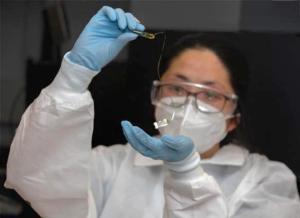
Due to their high-density grid layout, small size and their ability to conform to the hippocampal surface, the LLNL-developed micro-electrode arrays provided researchers with a critical “birds-eye-view” of how traveling waves moved and reversed over the surface of the hippocampus. Photo by Julie Russell/LLNL
Electrodes on the brain
Researchers at Lawrence Livermore and UC San Francisco have observed a new feature of neural activity in the hippocampus — the brain’s memory hub — that may explain how this vital brain region combines a diverse range of inputs into multi-layered memories that can later be recalled.
Using a special “micro-grid” recording device developed by scientists at Lawrence Livermore National Laboratory, the UCSF researchers were able to measure hippocampus activity in study participants undergoing surgery to treat severe epilepsy.
They discovered that brain waves travel back and forth across this structure, integrating messages from different areas of the brain, and showed for the first time what scientists previously had only been able to hypothesize.
“Brain recordings are an important part of guiding epilepsy surgery,” said Dr. Edward Chang, chair of the Department of Neurological Surgery and the senior author on the study. “The new high-density electrode grid technology used here allowed us to see a novel property of hippocampal activity that was previously unknown.”

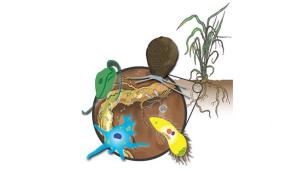
Protists, a diverse group of eukaryotic microbes, respond to the plant’s influence on the physicochemical and biological properties of the root zone in a similar way as previously observed for bacteria and fungi. Protists interact with other rhizosphere microbes through predation and can be plant pathogens. Image by Javier A. Ceja-Navarro/Lawrence Berkeley National Laboratory.
Dishing the dirt
Plants evolved in a world dominated by prokaryotic and eukaryotic microbes. Underneath the surface, plant roots interact with microbes in the soil, also called the rhizosphere microbiome.
Although bacteria and fungi are well-studied in the rhizosphere (the layer closest to the roots), other components, including viruses and protists, are less well known. A protist is any eukaryotic organism (an organism whose cells contain a nucleus) that is not an animal, plant or fungus. Most protists are unicellular, and many in soil are predators—i.e. they feed on bacteria, fungi, algae — or parasites.
To better understand the extent to which biological and environmental factors shape protist communities, a Lawrence Livermore National Laboratory researcher and collaborators analyzed protist communities associated with the rhizosphere and surrounding soil of switchgrass plants in different developmental stages. Switchgrass is a prairie grass native to the U.S. that has excellent potential as a bioenergy feedstock and is of significant interest to the Department of Energy. The team found that the diversity of protists was lower in the rhizosphere than in the bulk soil and that the composition of protist communities changes through the different phenological stages of the plant.

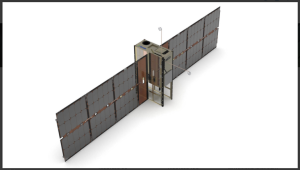
The Tyvak 6U cubesat developed by Lawrence Livermore and Tyvak.
Tiny telescope lifts off
The Tyvak-0130 rideshare payload that flew to orbit May 15 on a SpaceX Falcon 9 carries a miniature space telescope for possible commercial use.
The technology was developed by Tyvak Nano-Satellite Systems and Lawrence Livermore National Laboratory under a four-year agreement to advance compact telescopes for commercial applications.
This is the third mini-telescope deployed by Tyvak since 2018. The company wants to pave the way for commercial space situational awareness services.
Lawrence Livermore has developed mini-telescopes that range in size from one inch to 14 inches. Tyvak is studying options to commercialize the Lab’s space telescope technology.

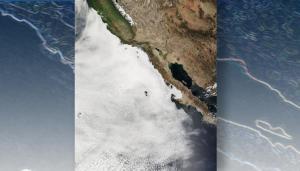
Marine stratocumulus clouds along the California and Baja California coastlines, as revealed by a NASA satellite. LLNL researchers have found that global warming causes low clouds over the oceans to decrease, leading to further warming. Image courtesy of NASA.
Cloudy outlook on global warming
A new analysis of satellite cloud observations finds that global warming causes low-level clouds over the oceans to decrease, leading to further warming, according to researchers at Lawrence Livermore National Laboratory, in collaboration with colleagues from Scripps Institution of Oceanography and the NASA Langley Research Center.
The analysis of satellite observations helps to reduce a long-standing climate change uncertainty: How will marine low-level clouds evolve as the planet heats up, and how will this feed back on warming? These clouds, such as the stratocumulus clouds responsible for the often gloomy conditions of San Francisco summers, are widespread over the global oceans and strongly cool the planet by shading the surface from sunlight.
The new study finds that, overall, this cooling effect will be modestly reduced as the concentration of carbon dioxide (CO2) in the atmosphere increases. The warming initially caused by increasing CO2 gets an extra push from reductions in clouds — an amplifying feedback.





